Florida is a stunning state in the southeastern region of the United States. Known as the Sunshine State, Florida is famous for its sub-tropical climate. From its barrier islands to the Florida Everglades, there is a vast array of ecosystems in the state that are the perfect home for thousands of fascinating animals. Florida’s animals are just as diverse as the state and come in all different sizes and shapes.
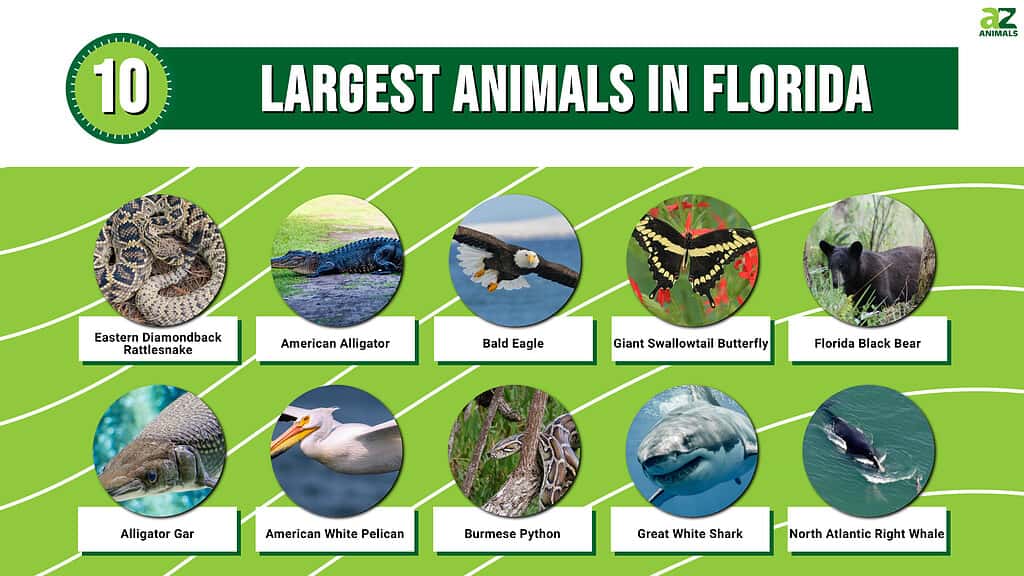
So join us as we discover some of the largest animals in Florida and where you’ll find them!
1. Eastern Diamondback Rattlesnake

Eastern diamondback
rattlesnakes
are dangerous and large.
©Chase D’animulls/Shutterstock.com
There are six venomous snakes in Florida and the largest is the eastern diamondback rattlesnake which reaches approximately 8 feet long. These snakes have thick, heavy bodies which are typically yellowish-brown and overlaid with dark brown or black diamond-shaped markings. Eastern diamondbacks are credited with being the most dangerous snake in Florida (and the whole of North America) due to their long fangs and the large amount of highly toxic venom that they can inject with a single bite. However, although they can strike from a distance of four feet, they tend to give plenty of warning before striking. Eastern diamondbacks live in pine flatwoods and hammocks in Florida and are fairly common throughout the state.
2. American Alligator
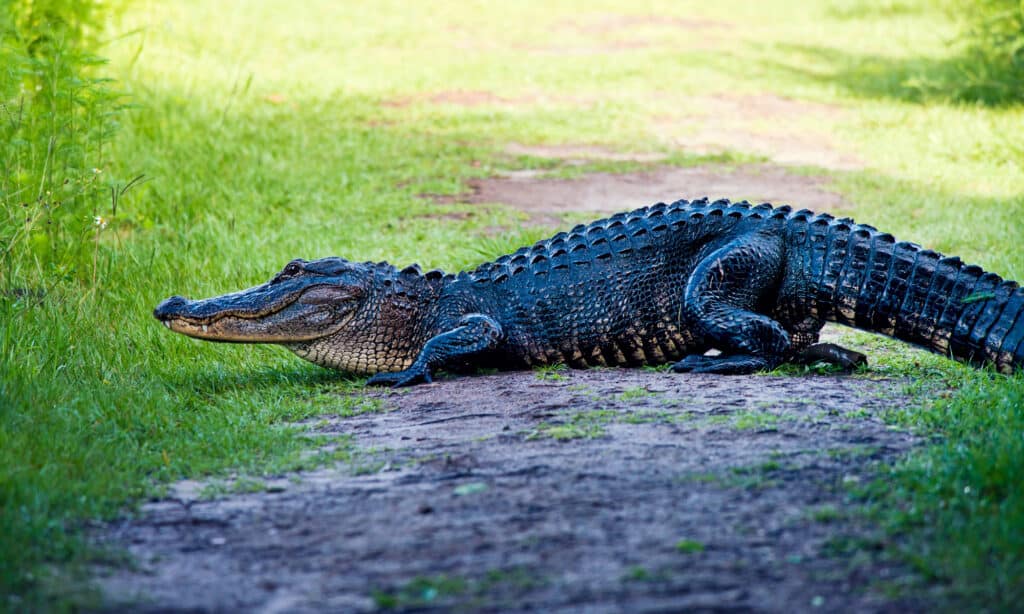
Florida has an estimated number of 1.3 million alligators.
©Svetlana Foote/Shutterstock.com
No list of largest animals in Florida would be complete without the mighty American alligator. Males are larger than females and the largest males can reach 19 feet long and weigh around 2,000 pounds. These huge reptiles inhabit freshwater areas – such as lakes, rivers, streams, and swamps. They are actually a keystone species as they create new ponds known as alligator holes which are then used by many other animals and help to retain water during the dry season. Alligators are apex predators and have an opportunistic nature. They prey on anything that they can catch, although their diet mainly consists of fish, birds, turtles, snakes, amphibians, and small mammals. Florida has an estimated 1.3 million alligators which can be found all over the state. However, Lake George in northwest Florida is home to approximately 2,300 alligators and is one of the best places to see them.
3. Bald Eagle

Bald eagles are seen in most coastal regions of Florida.
©Jack Molan/Shutterstock.com
One of the biggest and most common birds in the state is the stunning bald eagle which has a massive 7ft 7in wingspan. Easily distinguished by their dark brown plumage and white heads and tails, bald eagles can be found in most coastal regions of Florida as well as around major rivers and lakes. There are approximately 1,500 breeding pairs of bald eagles in Florida, which is one of the largest populations around, and one of the best places to see them is Prairie Lakes. As they are such big birds it’s not surprising that bald eagles need pretty big nests. In fact, they create the biggest nests of any bird in the world. They are made in trees and the largest can be around 20 feet deep and 9 feet wide!
4. Giant Swallowtail Butterfly
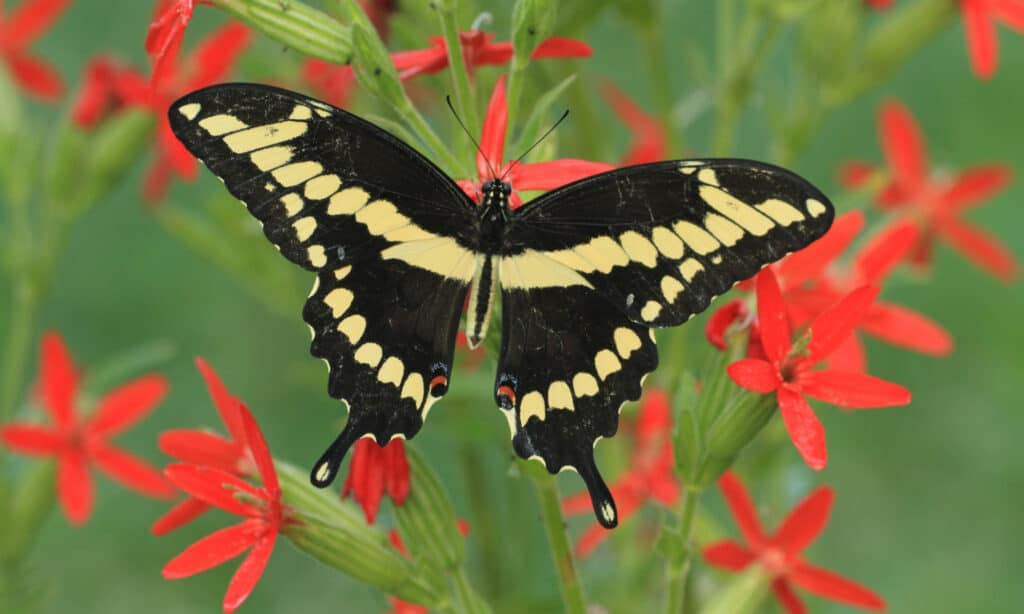
Measuring with wingspan, the giant swallowtail
butterfly
is the largest insect native to Florida.
©Kevin Collison/Shutterstock.com
There are many insects that are native to Florida and the largest is the giant swallowtail butterfly which has a massive 7-inch wingspan. Giant swallowtails are black with stunning yellow lines across their wings. They mainly inhabit pastures and deciduous forests. Florida is one of the few states where they are capable of overwintering and they are found in every county.
5. Florida Black Bear

Florida’s black bear is one of the largest animals in Florida.
©Robin Cabral/Shutterstock.com
The Florida black bear is a subspecies of the American black bear and is one of the largest animals in Florida. Florida black bears have a shiny black appearance and weigh an average of 300 pounds, although the heaviest males are known to weigh up to 760 pounds. These bears are mainly solitary and are very shy and secretive. They typically live in forest regions – especially upland forests and forested wetlands. Although Florida black bears once lived across the entire Florida mainland and some of the Florida Keys, their range is now much smaller. Today, they occupy areas such as the Ocala, Apalachicola, and Osceola National Forests.
6. Alligator Gar
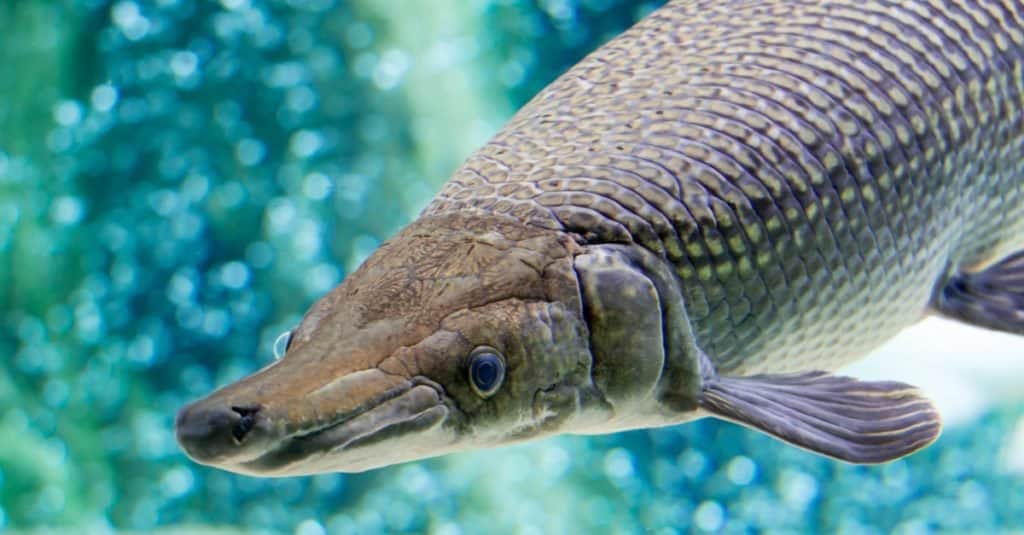
Alligator gars are fierce predators.
©Bill Roque/Shutterstock.com
One of the largest freshwater fish in Florida is the alligator gar which reaches 10 feet long and weighs up to 350 pounds. Alligator gars are the largest members of the gar family. They are usually an olive-brown color and have a torpedo-shaped body and a broad snout. Alligator gars prefer slow-moving water such as slow-moving rivers, lakes, and bayous. However, they are also tolerant of brackish water and even occasionally occur in salt water. In Florida, alligator gars mainly live in rivers in the Panhandle region. They are fierce ambush predators and prey on a wide range of fish as well as birds, turtles, and crabs. These fish are widely regarded as sport fish and the largest caught in Florida weighed 132 pounds.
7. American White Pelican
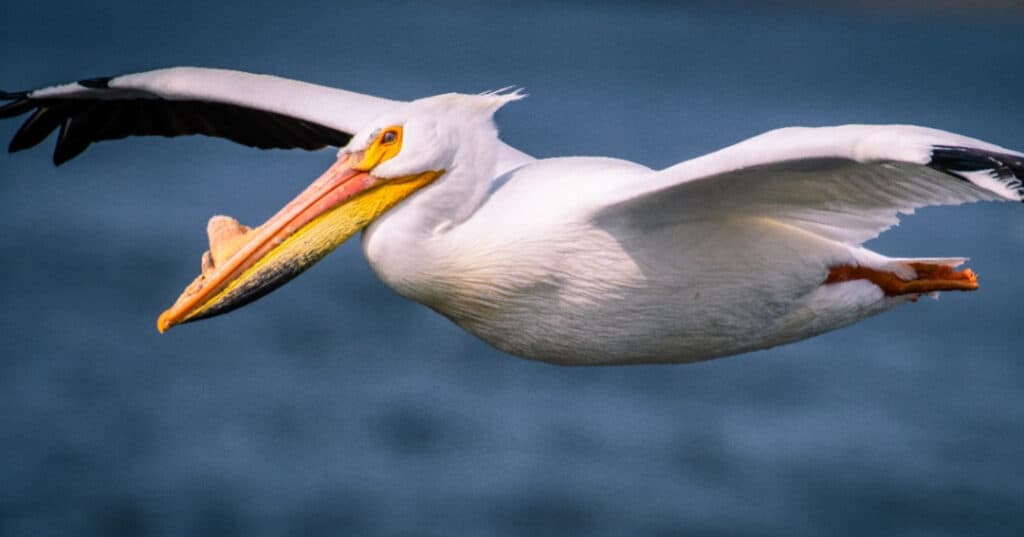
American white pelicans have a wingspan of up to 10 feet.
©Jerek Vaughn/Shutterstock.com
The largest bird in Florida is the American white pelican which has a huge wingspan of 8 to 10 feet. American white pelicans are white birds with a long, orange bill. They live in wetland areas – such as lakes, rivers, marshes, and along coastlines where they eat fish and amphibians. American white pelicans nest in large colonies which can consist of up to 5,000 breeding pairs. They nest on the ground in a shallow depression lined with twigs and reeds. These birds are not present in Florida all year round, instead, they only inhabit the state during the winter. White Pelican Island on the west coast is the best place to see them. It has the largest population of American white pelicans in the entire southeastern region of the United States.
8. Burmese Python
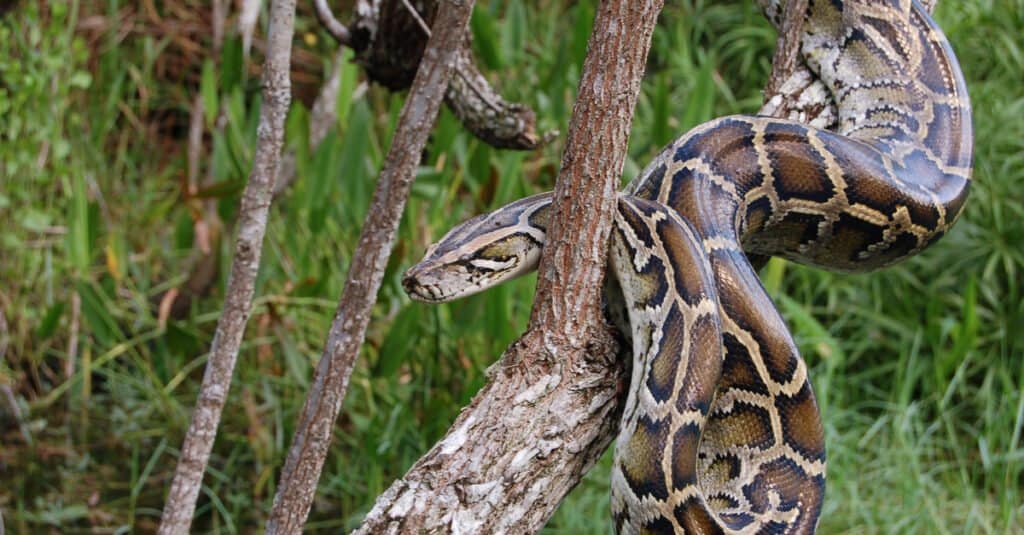
Burmese
pythons are invasive species in Florida.
©Heiko Kiera/Shutterstock.com
Incredibly, the largest snake in Florida is not actually a native species. Instead, it is the highly invasive Burmese python which typically reaches 16 feet long, although there are reports of longer individuals. Burmese pythons are dark brown with brown blotches on their sides. They are native to southeast Asia but were introduced to Florida in 1979 via the pet trade. Their population quickly increased and they have become one of the most invasive species in the state. Burmese pythons live near permanent water sources and are most often found in the Florida Everglades. They eat a variety of birds, mammals, and amphibians and frequently prey on endangered native species – such as Key Largo woodrats. Due to this and their lack of natural predators, Burmese pythons have become a dominant force in Florida and most native species just can’t compete against them.
9. Great White Shark
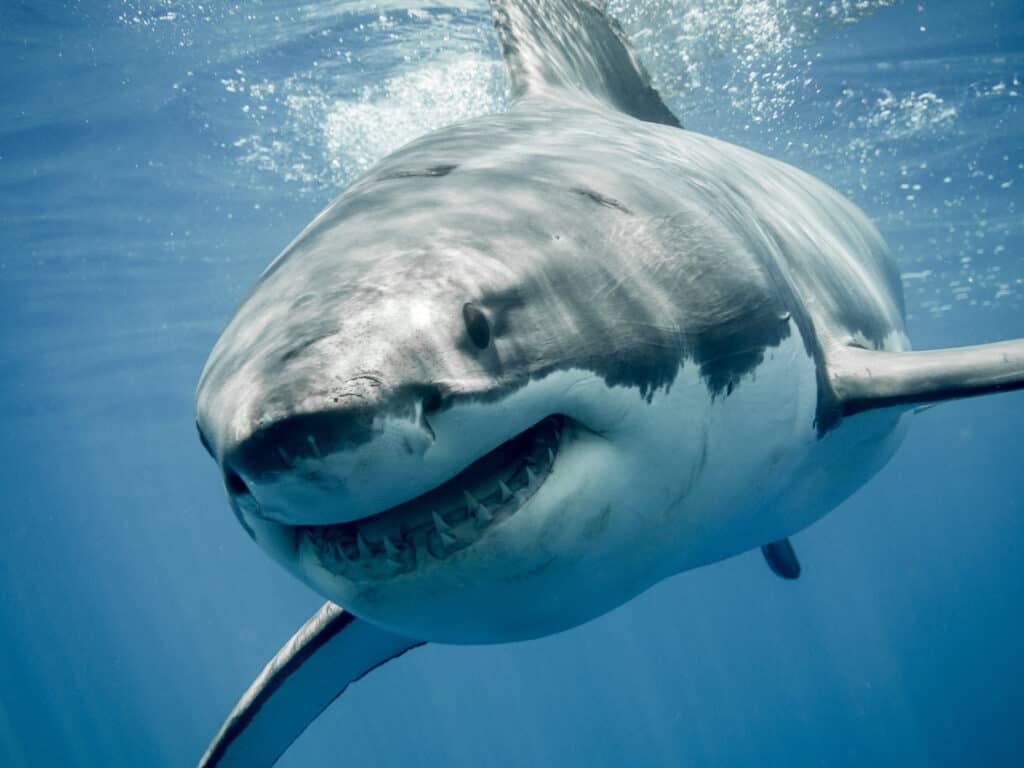
Great white sharks are spotted on the south coast of Florida.
©Ramon Carretero/Shutterstock.com
The largest fish in Florida is actually the notorious great white shark which averages 16 feet long, although the largest females have been reported to reach 20 feet. Great white sharks are possibly the best known of all sharks due to their deadly reputation, which is in part fueled by their voracious appetite and status as apex predators. These sharks inhabit waters between 12 and 24°C all around the world and can often be found in coastal regions. Great whites have often been spotted off the south coast of Florida. This year alone has already seen some of the largest great white in Florida be spotted cruising around near the coast – a 13ft long male off Port St Lucie in June and another estimated to weigh 1,600 pounds in March.
10. North Atlantic Right Whale

North Atlantic Right Whales are docile, baleen whales that tend to keep close to the coast.
©iStock.com/6381380
The largest animal in Florida is the critically endangered north Atlantic right whale. North Atlantic right whales can reach a maximum recorded length of 61 feet. They are typically dark grey to black with rough white patches of skin on their head, known as callosities. North Atlantic right whales are baleen whales. This means that they are filter feeders and mainly eat only small fish, krill, and plankton. The waters around Florida are one of only a few calving areas for these massive whales. They are usually seen in the area in the winter between November and April. The area between Jacksonville and Cape Canaveral is one of the best places to see them.
Summary of the 10 Largest Animals in Florida
| Name of Animal | Size | Habitat |
|---|---|---|
| Eastern Diamondback Rattlesnake | up to 8 feet long | Pine flatwoods. |
| American Alligator | up to 19 feet long; up to 2000 lbs. | Freshwater lakes, rivers, streams, and swamps. |
| Bald Eagle | 7’7″ wingspan; 6.6-14 lbs. | Near large bodies of water. |
| Giant Swallowtail Butterfly | 7 inch wingspan | Pastures and deciduous forests. |
| Florida Black Bear | 300-760 lbs. | Upland forests and forested wetlands. |
| Alligator Gar | 10 feet long; up to 350 lbs. | Slow-moving rivers, lakes, and bayous, but tolerant of brackish, even salty water. |
| American White Pelican | 10 foot wingspan | Wetland areas: lakes, rivers, marshes, and coastlines. |
| Burmese Python | 16+ feet long | Mostly in the Everglades. |
| Great White Shark | 16-20 feet long | Waters between 54-75 degrees Fahrenheit. |
| North Atlantic Right Whale | up to 61 feet | Use Florida waters for calving. |
The photo featured at the top of this post is © iStock.com/ELizabethHoffmann
Sources
- Florida Museum (1970) floridamuseum.ufl.edu/florida-snake-id/snake/eastern-diamond-backed-rattlesnake/
- Florida Fish and Wildlife Conservation Commission, Available here: https://myfwc.com/wildlifehabitats/wildlife/bald-eagle/
- Florida Museum (1970) floridamuseum.ufl.edu/wildflowers/butterfly/giant-swallowtail/
- (1970)
Thank you for reading! Have some feedback for us? Contact the AZ Animals editorial team.






